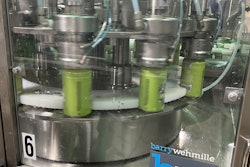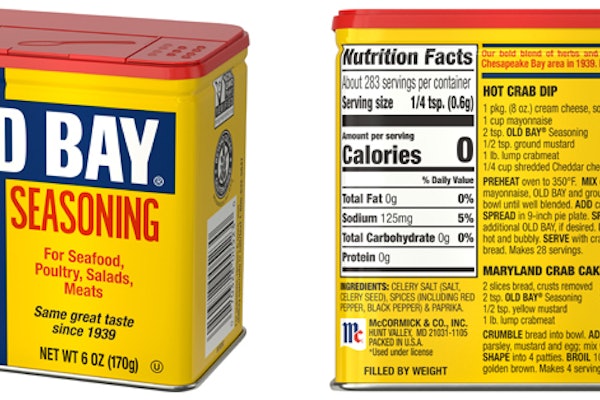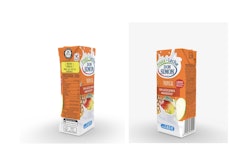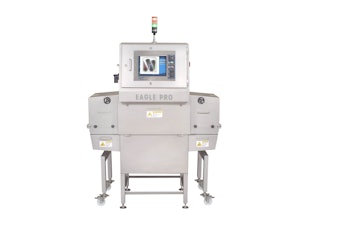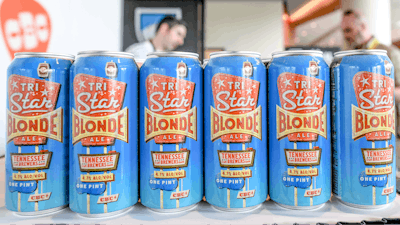
 Bart Watson, president and CEO of the Brewers Association
Bart Watson, president and CEO of the Brewers Association
Bart Watson, president and CEO of the Brewers Association: There are a lot of different factors at play. One of the clearest trends is that it's a tougher time to be an equipment manufacturer, that the secondary market for equipment is stronger, and people are looking there because there's a lot of value there right now. That takes multiple forms. We've long seen breweries “hermit crabbing,” where one leaves [a production and packaging location], and another one comes in [to take advantage of the existing equipment]. That trend continues. A lot of breweries look to just take over a space, and breweries with established brands do that a lot. They look for new spaces, but they don’t want to do full build outs anymore. They identify an area, wait for brewery to go out of business, and then they can move in. They can still customize to their own needs, but they don't have to go in with all new equipment. More operators have the patience to just wait to take over a space, rather than building everything custom.
What are these established breweries doing with their increased capacity, having taken over that capacity from an outgoing brewery?
At production breweries, the desire to build out new capacity is pretty low. When people are expanding, often they're doing so via contract or partner brewing, finding ways to gain that capacity with lower risk and lower capital expense. There’s just more secondary equipment out there, since closings have risen somewhat, and those prices have stayed low. When openings outpaced closings, you saw stainless was still holding its value incredibly well. There were times where banks would insure the stainless at low cost, because they knew they could get that back what people paid for it. Today, I hear there are some screaming deals out there of very cheap equipment. People are looking at the secondary market as opportunities for breweries who do want to expand, because there is a lot of equipment out there, and you can get at much better pricing.
That’s an interesting equipment dynamic. But even if the total number unique brewery brands or businesses is decreasing, the number of locations might be more static, and the total volume of beer sounds to be flat. Do I have that right?
Yeah. Most of the closings are still really small breweries. One of the transformations we've seen over the last decade or two is most of the breweries that open now are small tap rooms, brew pubs, and hospitality folks. In the grand scheme of capacity, they don't move the needle much. I think that's another reason we're seeing breweries, when they want to scale up, go with a partner [as private label brewer or contract packager] as opposed to building out their own big production brew house. That capacity exists already. It's much cheaper to test the market that way, than to build out a major facility and hope for the best. But generally, I don't think we've seen capacity change that much. There have been a few bigger facilities that have come off-line, but often their equipment disappears into the secondary market and reemerges with growing breweries. The capacity has been pretty stable in recent years.
Sounds like co-man, co-pack, and private label is a growing trend in craft brew. What does that landscape look like?
There are two flavors of contract brewing. There are breweries that are speciality-built for it. We saw a wave of that over the last five to 10 years. With breweries like Sleeping Giant here in Denver or Brew Hub in Florida, contract is their main market. But we've also seen breweries that have a lot of capacity lean into that fact, realizing they can use that capacity to produce for other people. And sometimes you see hybrids. Prost Brewing here in Colorado just built a big second facility, and it was built with the idea that they were going to make their own beers, but they were also going to have capacity to contract brew. A lot of the regional craft breweries who have had excess capacity have been looking for people to bring in, looking for partners, looking for people for whom they can brew. I think that's going to increasingly be part of the landscape going forward.
We’ve been beating the “shift to cans” drum for a few years, and now, cans are king. Some breweries have transitioned entirely away from bottles. Meanwhile, aluminum has been topsy turvy lately on several fronts. For starters, minimum order quantities (MOQs) for printed cans hit all-time highs during the pandemic. But now, those MOQs seem to be falling to more attainable quantities, even for smaller brewers. Is that the case, and if so, what do you make of this shift?
A lot of breweries had already found workarounds when those minimums (MOQs) went up. They might go through a broker, who might meet an MOQ, but the brewer only buys a chunk of that inventory. So really, brewers adapted their supply chains as those MOQs went up, and I don't think they’ve necessarily moved them back. Brewers have long memories, and when they get burned with the supply chain, they're wary to buy back in. But this coincided with craft brewers seeing some of the most challenged sales on package distribution. So you have winners and losers. There are brewers who have leaned back into getting printed cans where they can. It drives cost efficiencies, if you can do that versus a shrink or digitally printed can. But we've also seen brewers who have come down in volume with the overall market, so they don’t need as many cans. I remember telling this to can suppliers at the time [when their MOQs were high during the packaging-reliant pandemic years], ‘this is short-sighted, because you're reacting to a [pandemic era] blip in what the industry looks like, at least in terms of package sales. That's going to go back down.’ And that's exactly what happened. Suddenly, there was a lot of capacity available, and craft brewers have seen those package sales also decline. So that’s something else that has re-equilibrated.
The latest wrinkle in aluminum is tariffs, particularly those that might be imposed on Canadian suppliers. How are craft brewers thinking about Canadian aluminum?
It’s going to be challenging. Right now, a lot of it is waiting and seeing what exactly it’s going to look like. We've had steel and aluminum tariffs in place since 2018, but what's different now is the administration is talking as if there aren't going to be any exemptions. In 2018 they put aluminum and steel tariffs on in place under Section 232, but then they exempted most of our largest trading partners, Canada especially. Our math suggests about 10% of every can in the U.S. is using Canadian aluminum. The rest is mostly sourced domestically, with some other countries involved. But they've had an exemption, so they have not been part of the tariff regime. If they’re part of the tariff regime, that's going to raise the cost environment, and that's going to be challenging for a lot of small brewers. If you go back five or 10 years, a lot of brewers were doing both cans and bottles. Now most brewers are just doing cans. They don't have a bottling line that they can pivot to. It's unclear if they would have pivoted anyway, or what the cost structure would have looked like. But this is going to be a challenge for craft brewers. I think aluminum is the tariff that we're more worried about. Steel certainly is going to impact equipment manufacturers, as well. Brew houses, fermenters, fillers, and case packers are made with steel. The cost of steel is up, so the cost of that equipment is going to go up. But for brewers, there's also that secondary market for equipment. And now there's some other options. Kegs are in steel, and the vast majority of those are imported. We don't make a lot of kegs in the U.S., we mostly get them from abroad. Our understanding is these steel aluminum tariffs are going to be on those raw materials only, not finished goods, and cans and kegs are finished goods. But we're watching. It's going to be a pain point if costs start to rise. Brewers are going to pivot as much as they're able, but depending on their warehouse size, you can only stack cans so high, and when you need to buy new ones, if they cost more, you're going to have to pay more. Brewers have worked hard to control costs as much as possible in the last few years. But there's only so much you can do, and it'll be interesting to see how brewers react. Will they be of eating that cost, and watching their margins erode? Or will they be passing it on to customers? Customers are more price elastic than they used to be. But if you pass it on, you risk losing some of that volume to somebody else who doesn't go up in price.
What are some packaging format trends or changes that you’ve seen in recent years, or do you expect to see going forward—at the Craft Brew Conference, April 28 to May 1 in Indianapolis?
The shift to cans has been one of the constants. It's been pretty steady over time. I kept wondering at what point it was going to slow down, but craft brewers now are beyond large brewers in terms of cans as share of package. It’ll be interesting to see if some craft brewers ‘zig’ back into bottles. I heard one brewer saying maybe they’ll go to bottles to stand out, which is one of the reasons people went to cans in the first place. Craft brew is contracting, in terms of number of breweries. But capacity has been mostly flat, revealing some consolidation of total numbers of brewers, and shrinking SKU portfolios.
Craft brew is contracting, in terms of number of breweries. But capacity has been mostly flat, revealing some consolidation of total numbers of brewers, and shrinking SKU portfolios.
What about other alternatives to printed cans?
During some of those printed can shortages over the pandemic, we'd seen an increase in interest in some of the other ways to decorate unprinted cans, in shrink sleeve labels or in digital printing. Some of that has persisted. Digital printing has been gaining a little bit more traction over time, as it has become a little bit more cost competitive, and as the technology has gotten a little bit better, a little bit faster. We've also seen label designs go everywhere. Some are as bright and colorful as possible, and some have moved back toward more simplicity counter to that. They’ve moved toward white and blank space on cans to try to stand out. On a shelf where everybody's multi-colored and rainbow, a white, clean appearance actually helps you stand out more.
Anything new in multipacks?
You still have variety packs, but fewer of them. Some of that has been at the expense of the original variety pack and craft, which is seasonal, and seasonal have struggled. Newer variety packs might just be IPA creeping into a new place, and variety packs of different types of IPAs taking over the place of seasonal brews.
How about secondary packaging? Are brewers moving toward cartonboard or paperboard multipacks?
Yeah, we’ve certainly have seen some of that. That's just another billboard for creativity. When you get that full design all around the product, that lets you do your branding and your designing a little bit differently. It can be more cohesive, than it would have been just with six packs with some sort of [can handle] holder on top. Speaking of those, we have seen some of the six pack holders on top change too. Some are minimalist in plastic, while others using paperboard or molded can rings and other things. We’re seeing some innovation in secondary packaging, and packaging in general. PW




